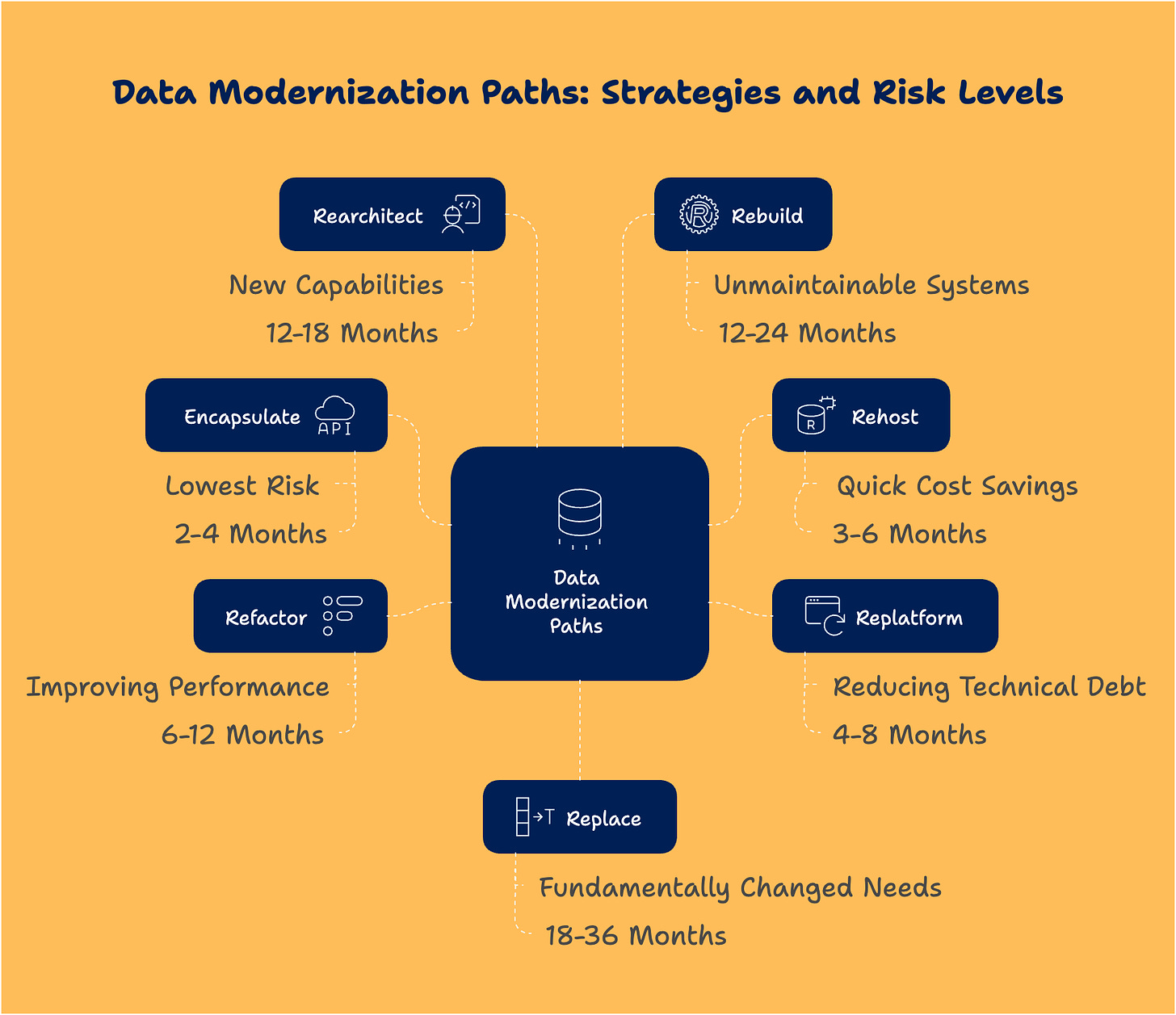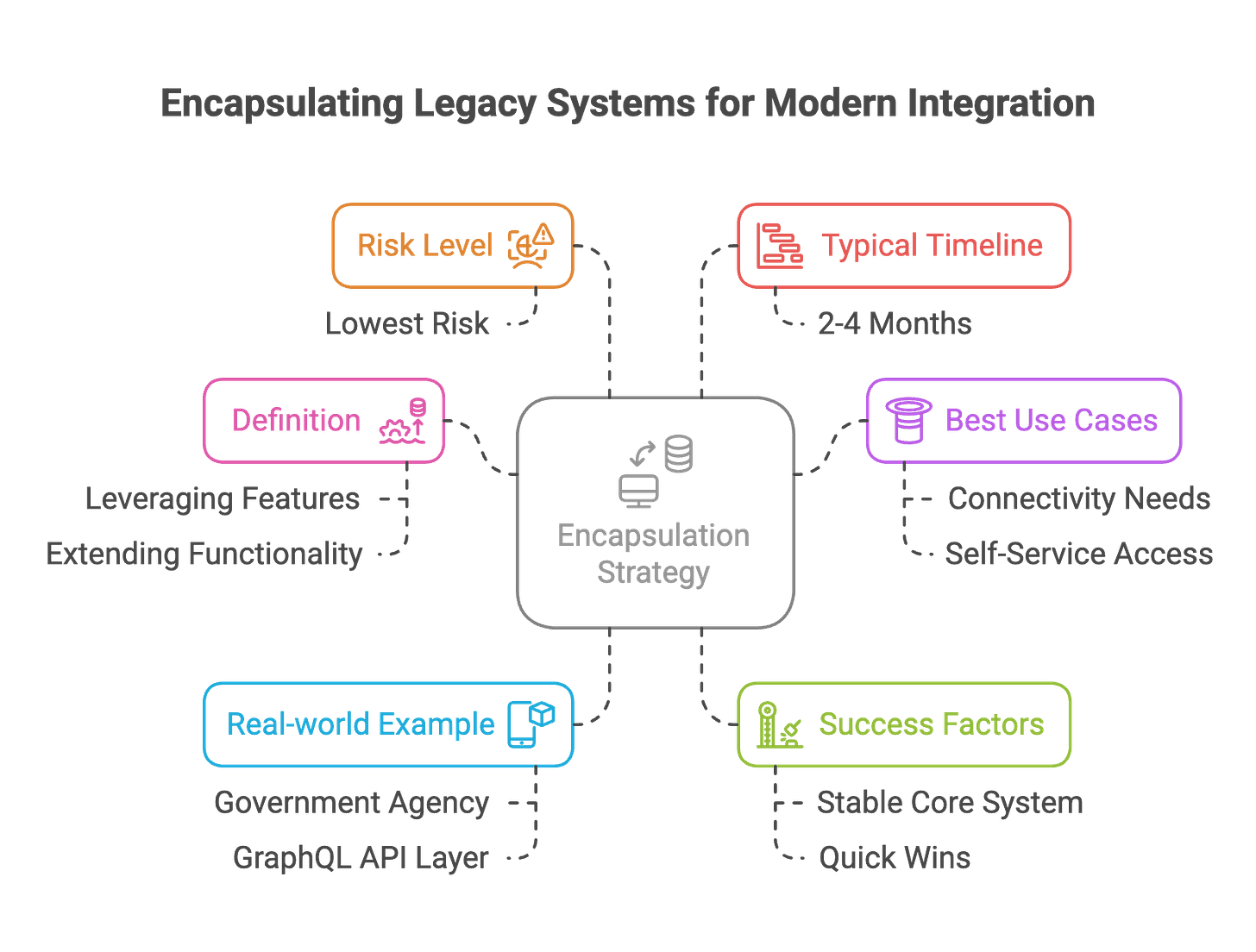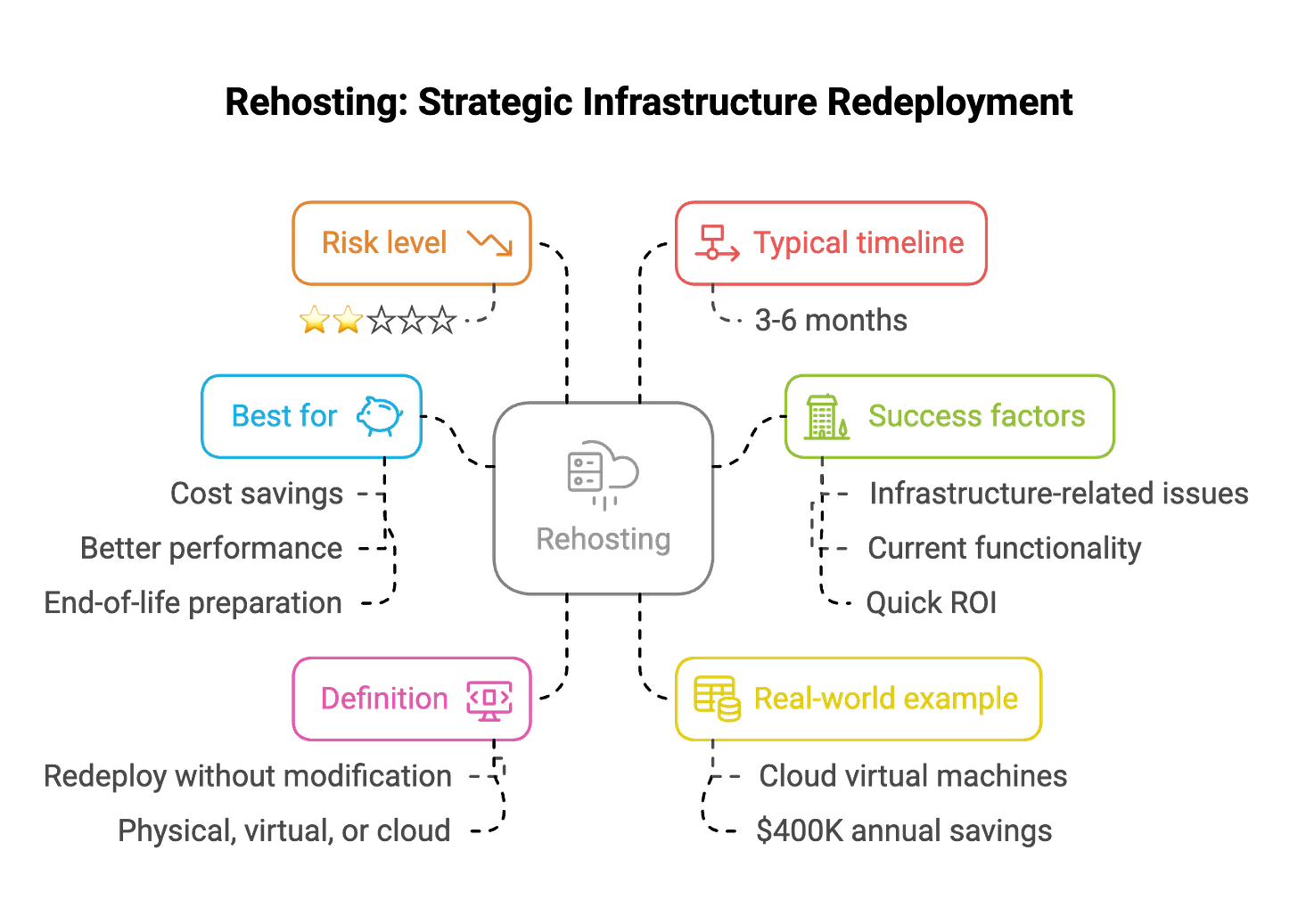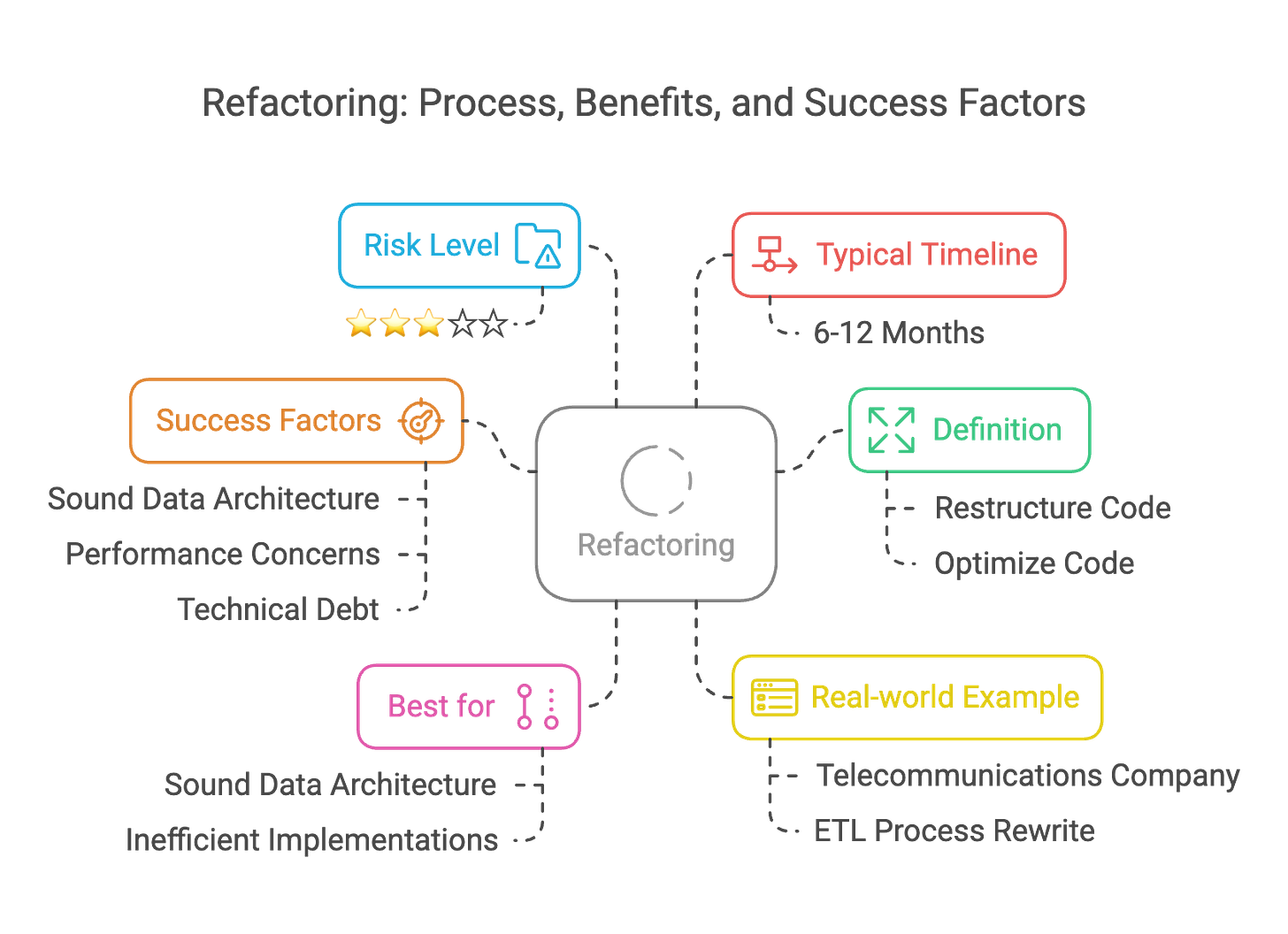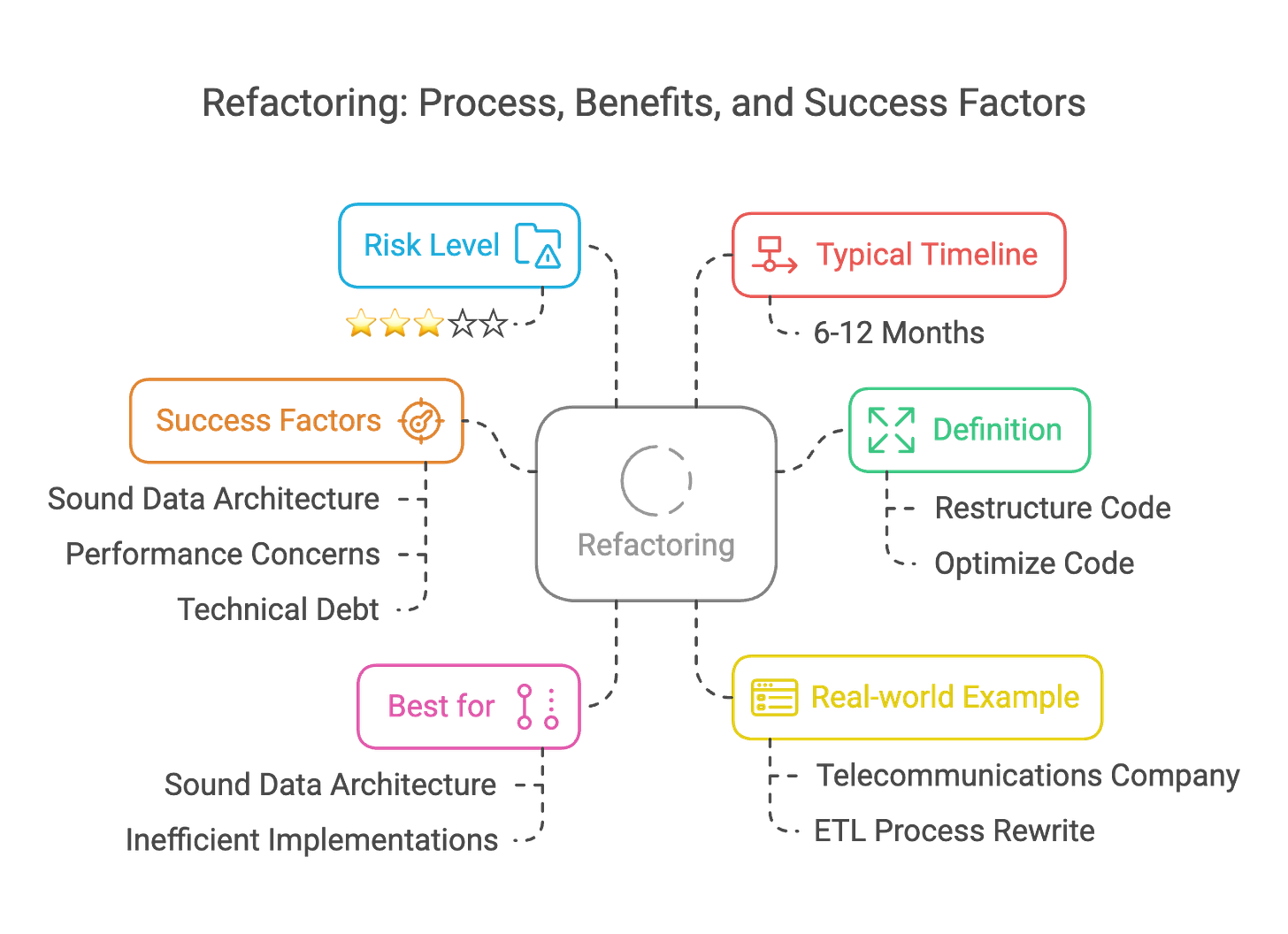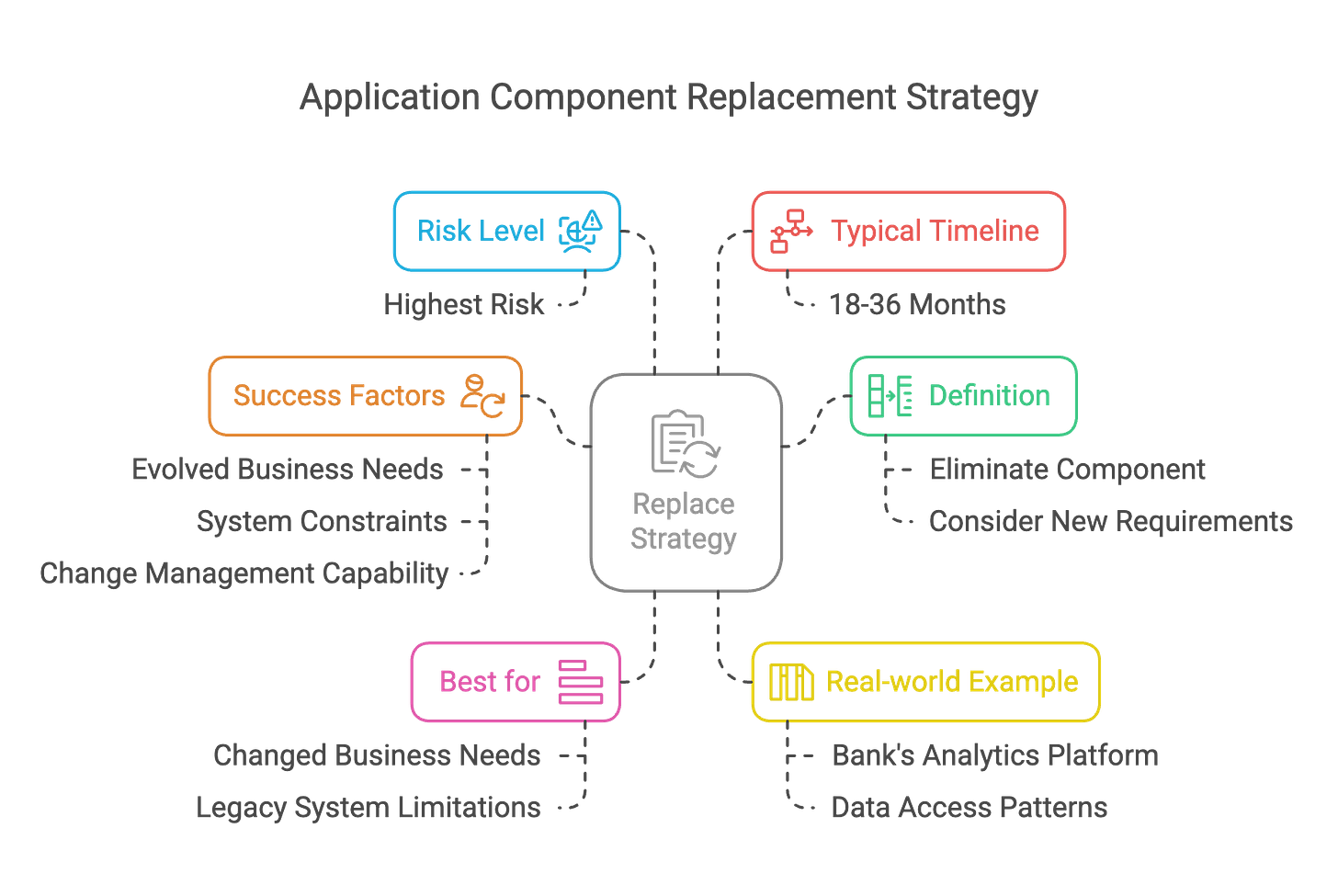#012 - The 7 Paths to Data Modernization: Choosing Your Risk-Reward Balance
From quick API wins to complete system replacement - which is right for you?
Hey there,
Choosing the wrong data modernization approach is the #1 reason why 70% of these projects fail.
Today, I'll walk you through the complete spectrum of data modernization options:
7 proven approaches ranked by risk level and implementation complexity
Clear indicators for when each approach is most appropriate
Real-world examples from financial services, retail, and government sectors
Let's break down your options...
7 Data Modernization Paths To Transform Your Infrastructure With Minimal Risk Even if You Have Legacy Constraints
To select the right modernization approach, you must understand the full spectrum of options and how they balance transformation potential against implementation risk.
Let me guide you through each option, from lowest to highest risk:
1. Encapsulate
What it is: Leverage and extend the application's features by encapsulating its data and functions and making them available as services via an API.
Best for: Systems that function well but must connect with modern applications or provide self-service access.
Real-world example: Implementing a GraphQL API layer over your existing Oracle database to expose customer data to mobile applications without modifying the underlying system.
Risk level: ⭐☆☆☆☆ (Lowest)
Typical timeline: 2-4 months
Success factors:
The core system is stable and performs adequately
The main issue is connectivity, not functionality
Need quick wins with minimal disruption
2. Rehost
What it is: Redeploy the application component to other infrastructure (physical, virtual, or cloud) without modifying its code, features, or functions.
Best for: Organizations looking for quick cost savings, better performance, or preparing for end-of-life hardware/software.
Real-world example: Migrating an on-premises SQL Server data warehouse to SQL Server on Azure VMs or AWS EC2 instances using backup/restore.
Risk level: ⭐⭐☆☆☆
Typical timeline: 3-6 months
Success factors:
The primary issues are infrastructure-related
Current functionality meets business needs
Need to demonstrate quick ROI
3. Replatform
What it is: Migrate to a new runtime platform, making minimal changes to the code but not the code structure, features, or functions.
Best for: Organizations looking to reduce technical debt or adopt cloud-native benefits without reinventing their data architecture.
Real-world example: Converting an Oracle data warehouse to Snowflake using automated schema conversion tools while maintaining the same data model.
Risk level: ⭐⭐☆☆☆
Typical timeline: 4-8 months
Success factors:
Current data models work well, but technology is limiting
Looking for improved TCO without business disruption
Data structure is sound, but platform capabilities are inadequate
4. Refactor
What it is: Restructure and optimize the existing code (although not its external behavior) to remove technical debt and improve nonfunctional attributes.
Best for: Organizations with sound data architecture but inefficient implementations that cause performance or maintenance issues.
Real-world example: Converting batch-oriented overnight ETL to near-real-time data streams using Kafka and Spark Structured Streaming.
Risk level: ⭐⭐⭐☆☆
Typical timeline: 6-12 months
Success factors:
Data architecture is fundamentally sound
Performance or maintainability is the primary concern
Technical debt needs addressing without disrupting interfaces
5. Rearchitect
What it is: Materially alter the code to shift it to a new application architecture and exploit new and better capabilities.
Best for: Organizations whose current architecture cannot meet evolving business needs or scale requirements.
Real-world example: Shifting from ETL to ELT architecture using a data lake (Azure Data Lake, AWS S3) with Databricks processing OR Transforming a monolithic Teradata EDW into a domain-oriented architecture with separate analytical stores in Snowflake for finance, customer, and product data.
Risk level: ⭐⭐⭐⭐☆
Typical timeline: 12-18 months
Success factors:
Current architecture is limiting business capabilities
Need improved flexibility and domain-specific optimization
Willing to invest in significant structural changes
6. Rebuild
What it is: Redesign or rewrite the application component from scratch while preserving its scope and specifications.
Best for: Organizations with clear requirements but systems that have become unmaintainable or impossible to extend.
Real-world example: Reimplementing an Oracle-based customer analytics platform as a cloud-native solution using BigQuery with dbt transformations.
Risk level: ⭐⭐⭐⭐⭐
Typical timeline: 12-24 months
Success factors:
The current implementation is fundamentally flawed
Business functions remain relevant, but technology doesn't
Strong requirements management capabilities exist
7. Replace
What it is: Eliminate the former application component altogether and replace it, considering new requirements and needs at the same time.
Best for: Organizations whose business needs have fundamentally changed or when legacy systems cannot be adapted to new requirements.
Real-world example: Sunsetting a legacy data mart architecture in favor of a Databricks lakehouse platform with new data models and analytical capabilities.
Risk level: ⭐⭐⭐⭐⭐ (Highest)
Typical timeline: 18-36 months
Success factors:
Business needs have fundamentally evolved
Current system constrains rather than enables the business
Organization can handle comprehensive change management
That's it.
Here's what you learned today:
The 7 modernization paths range from low-risk encapsulation to high-risk replacement, each with appropriate use cases
Lower-risk approaches can deliver quick wins with minimal disruption for specific pain points
Higher-risk approaches enable transformation but require greater investment in time and change management
The best modernization strategies often combine multiple approaches for different components
Remember, successful modernization isn't about being the most technically ambitious; it's about matching the approach to your specific drivers and constraints. For many organizations, a mix of approaches across different components delivers the optimal balance of risk and reward.
PS...If you're enjoying The Data Modernisation Playbook, please consider referring this edition to a colleague who's wrestling with legacy data systems. They'll thank you for saving them from a costly modernization misstep.
And whenever you are ready, there are three ways I can help you:
Data Modernization Readiness Assessment: A comprehensive evaluation of your current data infrastructure against the six drivers, delivered as an actionable roadmap with clear priorities. Learn more
Data Migration Consultation: A collaborative session to develop your organization's data migration approach, technology selection, and implementation plan. Book a call
Migration Implementation Support: Hands-on technical guidance for your team throughout the migration process, from proof-of-concept through testing and cutover. Contact Us
That’s it for this week. If you found this helpful, leave a comment to let me know ✊
I am Khurram; I help businesses modernize legacy data systems for AI-ready, data-intelligent futures | Founder & Principal Consultant – BigDataDig
See you next Tuesday.


